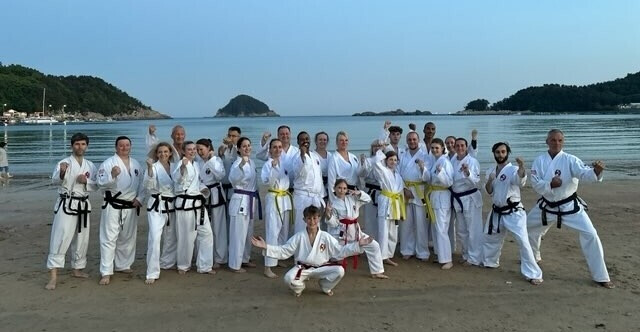
Namhae County, South Korea – In a unique convergence of martial arts training and cultural immersion, a delegation of Taekwondo practitioners from Switzerland and the United States recently concluded a significant visit to Namhae County as part of the International Taekwondo Federation (ITF)'s esteemed 'Tul Tour' program. This marked the first time the annual program, a cornerstone of ITF's global outreach, has chosen the historically rich region of Namhae as its training grounds, adding a profound layer of meaning to the participants' experience.
The visiting delegation, comprising a substantial number of members from prominent traditional Taekwondo organizations across Europe and the United States, was under the leadership of Representative Brunner, a highly respected figure within the ITF community. Their participation underscores the growing international interest in the ITF's approach to Taekwondo, which emphasizes not only physical prowess but also the philosophical and historical underpinnings of the martial art.
The 'Tul Tour,' inaugurated in 2011, is a distinctive program designed to deepen practitioners' understanding of Taekwondo's 24 fundamental patterns, known as 'Tul' or 'Hyeong' (forms or sets). These patterns are more than just sequences of movements; they embody the philosophy, spirit, and techniques attributed to significant figures in Korean history. The 'Tul Tour' uniquely blends rigorous practical training in these patterns with immersive experiences in Korean history and culture, offering participants a holistic understanding of Taekwondo's heritage.
The selection of Namhae County as the primary training location for this year's tour was particularly significant due to the region's deep historical connections to several of the ITF's core Tuls. The itinerary thoughtfully integrated visits to key historical and cultural sites that resonate with the symbolism of specific patterns:
Chungmu Tul: Training sessions were held at Chungnyeolsa Shrine, dedicated to the revered Admiral Yi Sun-sin, and the adjacent Yi Sun-sin Marine Park. The 'Chungmu Tul' itself is named after Admiral Yi, a legendary naval commander who defended Korea against Japanese invasions in the 16th century. The pattern's movements are said to reflect his strategic brilliance and unwavering courage. Practicing this Tul in a place steeped in his legacy provided a powerful connection to the historical figure and the spirit of the pattern.
Won-Hyo Tul: Participants engaged in training at Bori-am Hermitage, a serene Buddhist temple founded by the influential Silla Dynasty monk Won-Hyo (617-686 AD). The 'Won-Hyo Tul' embodies the monk's philosophical depth and his efforts to unify the various schools of Buddhist thought in Korea. The tranquil and spiritual atmosphere of Bori-am offered a fitting backdrop for contemplating the intellectual and spiritual essence of this particular pattern.
Dangun Tul: The delegation visited Dangun Seongjeon, a shrine dedicated to Dangun Wanggeom, the legendary founder of the first Korean kingdom, Gojoseon (ancient Joseon). The 'Dangun Tul' comprises 21 movements, symbolizing the traditional founding date of Gojoseon in 2333 BC. Training at this sacred site allowed practitioners to connect with the foundational myths and national identity of Korea, which the 'Dangun Tul' represents.
Choi-Yong Tul: Training also took place at Muminsa Temple, which honors General Choi Yong (1316-1388), a distinguished military leader during the late Goryeo Dynasty. Known for his integrity and patriotism, General Choi Yong's spirit is reflected in the 'Choi-Yong Tul,' which emphasizes discipline and unwavering commitment to duty. Practicing in a place commemorating his virtues provided a tangible link to the ethical and martial principles embodied in the pattern.
Oh Chang-jin, the President of the International Taekwondo Federation, emphasized the profound significance of the 'Tul Tour' in promoting Korean culture and the spirit of its historical figures. "The Taekwondo Jongjukguk experience program is a vital Hallyu initiative, transmitting the history of Korea and the indomitable spirit of its heroes to Taekwondo practitioners worldwide," he stated. He further highlighted the unique value of Namhae County, noting, "Training in locations intrinsically linked to the Taekwondo Tuls, such as Chungnyeolsa and Bori-am, offers an unparalleled and deeply meaningful experience."
President Oh also recognized Namhae's exceptional position in possessing sites connected to multiple key Tuls. "Namhae County is a rare gem, home to locations associated with the Chungmu, Won-Hyo, Dangun, and Choi-Yong Tuls. It is akin to a sacred ground that can deeply resonate with the 60 million Taekwondo practitioners globally," he affirmed. He expressed the ITF's commitment to future collaboration with Namhae County, stating, "We will continue to partner with Namhae to co-develop and expand global Taekwondo training and tourism programs, leveraging the region's unique historical and cultural assets."
A representative from Namhae County echoed this sentiment, emphasizing the region's strategic advantage. "Namhae County uniquely encompasses sites directly related to the foundational Taekwondo Tuls of Dangun, Chungmu, Won-Hyo, and Choi-Yong. We aim to capitalize on this by actively promoting tourism that is deeply intertwined with our rich cultural heritage," the official commented. Highlighting the significance of the visit in the context of the "Year of Visiting Hometown Love" in 2025, the official added, "We sincerely hope that this 'Tul Tour' will leave a lasting impression on the participants, fostering a sense of Namhae County as the 'hometown of Korea' in the hearts of Taekwondo practitioners worldwide."
The visit of the Swiss and US Taekwondo delegations to Namhae for the ITF 'Tul Tour' is being lauded as a significant event that transcends mere martial arts training. It represents a meaningful cultural exchange and a strengthening of international ties between global Taekwondo practitioners and South Korea, particularly the historically significant region of Namhae County. By connecting the physical practice of Taekwondo with the rich tapestry of Korean history and philosophy, the 'Tul Tour' in Namhae has undoubtedly provided participants with a deeper and more profound understanding of the martial art's essence and its cultural roots.
[Copyright (c) Global Economic Times. All Rights Reserved.]






























